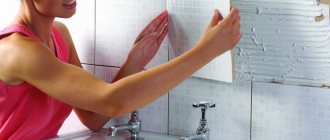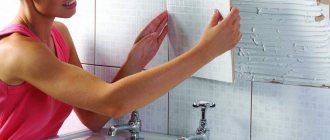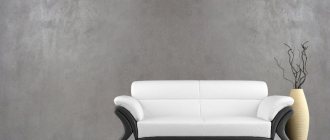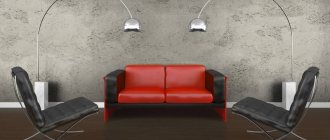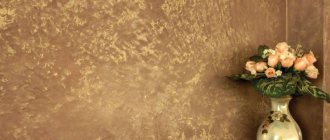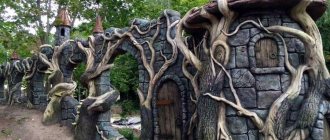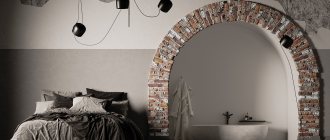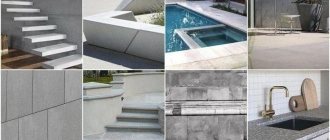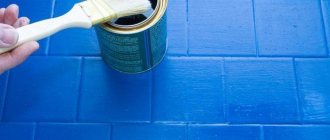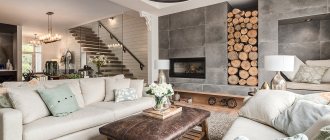Concrete bathroom - design
Everything in the world around us is subject to transformation, especially if we are talking about such a creative field of human activity as interior design.
Previously, concrete, a rather specific material for the design of residential premises, could be seen exclusively in interiors decorated in an industrial style. Today, designers are increasingly using it when creating interiors in other, more traditional styles. Concrete is suitable not only for various design areas, but also for rooms with different functional purposes: bedroom, living room, kitchen or hallway. Of particular interest are modern design projects in which concrete surfaces decorate bathrooms. The interior of such premises can be characterized by such words as calm, stylish and original. In the article we will talk about such a new trend as a concrete bathroom .
A great option for using concrete as part of a bathroom interior is a concrete countertop under the sink . A non-standard move is a combination of such a futuristic element with classic interior items, for example, with mirrors framed in bronze or gilded frames.
The use of concrete for kitchen and bathroom countertops has been made possible by the introduction of technological advances into design. Such interior items are created from fiberglass reinforced concrete . As a result, this rather massive material becomes lighter in the interior of a concrete bathroom. While the traditional method of constructing concrete walls and flooring uses reinforcement to maintain the integrity of the structure, fiberglass reinforcement avoids this.
If your goal is to add a little personality to your bathroom, then installing a concrete sink . This type of bathroom design element looks most harmonious in combination with wooden surfaces and interior items.
For those who want to see more concrete in their own bathroom, it is worth taking a closer look at a full-fledged concrete bathtub . Since such a piece of furniture is in low demand, such bathtubs are most often made exclusively to order. Therefore, a concrete bathtub will fit perfectly into your bathroom, because the parameters you specified are taken into account when creating it.
Concrete is a material that gives designers great freedom in the manufacture of various interior elements. a solid concrete structure will fit perfectly into the frame of a concrete bathroom . However, it must be taken into account that concrete is a rather specific material, the characteristic feature of which is the porosity of the structure . In order for its appearance to remain unchanged for as long as possible, it requires special care and protective coating. You can care for concrete surfaces only with products with a neutral pH.
In modern design, tiles that imitate concrete are in great demand. Its appearance depends on the style of the room. For an industrial design, an imitation of a rough and untreated surface is suitable, and for a classic interior - smooth tiles. A more interesting option is not just tiles, but small mosaics that also imitate concrete.
If we talk about the use of concrete in the interior of a bathroom, then one of the most rational solutions is a concrete floor . In addition to its stylish appearance, such a coating is very practical, as it does not require much time to clean.
encaustic tiles made from cement to decorate your bathroom Such a non-standard detail will give the interior a new sound thanks to the intricate patterns on the surface and soft texture. A sealing coating is placed on top of such tiles, which is recommended to be replaced annually with a new one.
The classic color palette for a bathtub with concrete elements is all kinds of interpretations of gray and white color combinations, complemented by wooden details . But you shouldn’t limit yourself to traditional colors; if you like bright solutions, then feel free to use rich shades in the interior.
Even if you settled on a traditional color scheme, you can enliven the design with the help of interesting lighting . For example, it can be multi-level or colored. As a result, you can adjust it depending on the time of day, the weather outside or your own mood. Such lighting will look most impressive against the background of a concrete surface.
Concrete is a material that fits perfectly into the framework of modern interiors, characterized by a special style and individuality.
Source
Stripping
After 5 days, when the concrete had set well, I disassembled and removed the formwork - there were no problems with this, the front panel came off quite easily. But there were difficulties with removing the template - it was not possible to remove it by hand. I had to build supports and gradually pull it out using screw clamps. I only had two of these clamps, so I had to rearrange them and lift the edges one by one. When the template came off the concrete, I pulled it out with my hands.
Then I sanded the entire concrete surface with sandpaper, and ground the edges a little so that they were not sharp. Since there were a lot of pores and cavities in the concrete, I sealed them with putty based on white cement (I first vacuumed and primed the surface). Then I sanded it again and polished it with a felt wheel.
Decorative concrete for walls + 28 photos with examples of work
Modern design solutions require the use of new and, often, original finishing materials. Walls in the loft style, minimalism, hi-tech - you can increasingly see them not only in pictures of magazines, but also in the apartments of your friends. Every day the construction market is replenished with a variety of wall covering options, from paint to “liquid” wallpaper. But the so-called decorative concrete is gaining the greatest popularity.
Have you decided to freshen up the renovation of your apartment? Choose decorative concrete-like plaster for interior wall decoration - it looks non-trivial and minimalistic, and has many positive characteristics.
6 wall finishing options that will be relevant in the next 10 years
An important element in home design is decorative wall decoration, which will make the apartment cozy and comfortable. And the choice doesn’t have to be limited to just painting or wallpaper.
We will discuss which options are most relevant and what are the advantages or disadvantages of each of them together with experts.
Experts in this article:
Types of plasters for concrete
Like any building material, decorative concrete plaster has several varieties. All of them are very popular among designers implementing renovation projects for modern houses and apartments.
Decorative concrete is divided into microconcrete and microcement. The features of each material allow them to be used in any room, to implement not only decorative, but also practical functions.
Microconcrete is a cement mixture with the addition of various polymer components, dyes and quartz chips. The finished solution is plastic and has excellent adhesion properties.
Thanks to the water-repellent properties of microconcrete, a wall coated with this material will not become covered with mold, mildew, or become a breeding ground for insects.
Concrete-look walls in the bathroom interior
Microcement is also based on cement and polymers. The mixture can be applied to both walls and floors - for example, as an insulating waterproof layer under tiles. Advantages of microcement:
This mixture is ideal for finishing bathrooms, kitchens and saunas. At the same time, the material can also be used for external work (on the facade of a building, steps, terraces).
Microcement can also be used on floors
This is interesting: decorative concrete does not have to be gray. Various colors and mineral chips added to the mixture will give it a unique look. In addition, the final result can be tinted or painted over with any type of paint.
Do-it-yourself concrete bathtub - materials and stages of creation
Given the abundance of building materials that has become familiar to us in recent years, it is difficult to imagine that choosing a container for washing could cause any difficulties. The most common models are made of cast iron, acrylic and stainless steel; at a low price, they provide high comfort in performing hygienic procedures and functionality.
More expensive, exclusive bathtubs are made from artificial or natural stone, glass and wood. However, quite often in construction practice there are situations when the only option to place a comfortable bowl of the required size is a do-it-yourself concrete bathtub, during the creation of which the master, like a sculptor, gives the product the desired shape.
Features of application
What associations do you have with the word “concrete”? In most cases, this is a gray, slightly rough and even dirty surface of the street wall. It is very difficult to imagine a concrete wall in the interior looking stylish and cozy, but we assure you that it can become an excellent backdrop for furniture, textiles and room decor.
Several features of “concrete” plaster:
Depending on what atmosphere you want to create in the room, you can choose the effect of wet or aged concrete or a surface damaged by rust. To create coziness in a living space, this finish can be combined with upholstered furniture, bright textiles, various paintings, panels and drawings.
Unusual decor will highlight the advantages of such finishing
Advantages and disadvantages of formulations
In addition to the advantages of the previously listed types of decorative concrete, there are several more noticeable advantages of this coating.
Decorative concrete for walls has the following positive characteristics:
Take note: painting the walls to look like concrete will allow you to complement the interior design with bright colors, original drawings, motivating inscriptions, etc.
The disadvantages of this material include:
Naturally, a significant disadvantage may be the fact that you simply do not like the look of partitions with decorative concrete as a finishing touch. That is why we recommend that you familiarize yourself in advance with photographs of interiors where this material is used.
Panels
This type of finishing is quite simple and practical. Decorative panels for wall decoration can be selected from different materials (PVC, MDF, gypsum and gypsum vinyl, bamboo, cork, glass). Moreover, they are presented in a wide palette.
The panels are durable, very easy to care for, and if any part is damaged, they can be easily replaced. Moreover, they are easy to install and there is no need to carefully level the walls - the panels hide all imperfections.
One of the disadvantages is that they “steal” space due to the volume of the structure.
Elena Sedykh:
— Decorative panels are very versatile - they can be made soft or hard, and you can choose any design. But you need to remember: the more voluminous the decor, the more difficult it is to clean. In addition, the materials can be expensive.
Application area
As mentioned earlier, decorative concrete can be used in almost any room. It could be:
In addition, such a finish will look good on the balcony, no matter whether it is isolated or not. But it is important to take into account the fact that the concrete coating has a certain weight, which will create a load on the floors - consider this issue carefully.
A wall decorated to look like concrete creates a bright contrast with the “plant” wall
Externally, decorative coating can be applied to:
In fact, the width of the range of applications of this material depends only on your imagination. Use certain parts of the room or buildings on the site as a canvas for design experiments, improvise - the greatest attractiveness is always those interior items that reflect the character and lifestyle of the owner of the home.
Selection of paint and varnish material
Previously, it was easier to choose paint, since the assortment was scarce. There are many paints on store shelves today, but not all of them can be used on concrete. It all depends on the operating conditions. Having considered the features, advantages and disadvantages, you can choose what to paint your concrete floor, ceiling or walls.
Oil-based paints and varnishes
The products are made on an oil base. It has long been used for painting interior and exterior surfaces. However, due to the toxic composition due to solvents, it is better not to use it inside. Has a pungent odor. Advantages:
To conclude, oil paint for concrete walls is good if you need to repaint a storage area or other exterior surfaces. After all, it is cheap and practical. But it is better not to use it for work around the house or garage.
Water based paint
Water emulsion and dispersion are an excellent option for interior painting. It is water-based, so it has many advantages. There are no harmful substances in the composition. It can be used to paint concrete walls, ceilings and interior floors. There are façade paints for exterior use. The packaging indicates for what purposes the composition can be used.
As for the disadvantages, the only thing we can note is the cost. It is low, but oil formulations are cheaper.
Acrylic paint
A universal option, it can be used to paint concrete ceilings, floors, walls inside and outside. It is based on acrylates, which give the composition special properties. The packaging indicates for what purposes it is used: “Ceiling”, “Facade”, “For walls”. Acrylic compositions are also used for artistic painting.
The downside is the cost. It is high. But if you consider the benefits, the price is justified. When choosing what to paint a concrete wall with, you can safely buy alkyd compounds.
Silicate based
It is also called glass paint, as it is based on liquid glass. Thanks to this, a durable film is created on the surface after painting, protecting the structure of the concrete surface. Suitable for indoor and outdoor surfaces.
Important! To find out the consumption of facade paint per 1m2, you need to look at the packaging. There are specific numbers there.
Advantages of silicate paints:
Their disadvantages are that they are expensive and contain toxic substances, so when working with them, it is important to take care of respiratory protection.
Advice! There is a rubber-based paint specifically for concrete surfaces. It is often used to paint concrete floors, as it creates a soft coating on the surface. It is elastic and not afraid of small cracks. She also perfectly tolerates all negative influences.
Impregnations for concrete
Painting walls requires preparation. Before the process, it is better to coat the surface with a special impregnation. This will preserve the surface from dirt, moisture and aggressive environments. The impregnation will penetrate the concrete structure and strengthen it. The compositions are made on an acrylic base, polyurethane or epoxy resins. In addition, preliminary application will reduce paint consumption. After all, concrete has a porous structure and absorbs liquids well.
After applying the impregnation, the wall will dry in a few hours (exact time on the packaging). After this, the wall, floor or ceiling will be ready for painting. The impregnation itself is transparent and may also have additional properties, for example, antiseptic. Having considered the features of paints, you can choose what to paint your concrete floor with.
Tools for surface preparation and plastering
If you are wondering how to make a concrete wall in the interior of an apartment with your own hands, start by purchasing the tools necessary for the plastering process.
So, you will need:
At different stages of preparation for work and the process of plastering the wall itself, other additional tools may be needed.
A set of necessary tools
Advice: the basic set of tools can be purchased in the same department where plaster is purchased - experienced consultants will also be able to help you choose the options that are suitable for your purposes.
Installation of formwork
Before starting work on creating a concrete washing container with your own hands, you need to build a hydraulic trough from rolled, painted or coated waterproofing materials in order to avoid leaks during operation. After drying, the screed is primed several times with a special deep penetration compound. Installation of formwork is carried out according to the following scheme:
- The frame of the boots of the future font is made from metal reinforcement with a diameter of 6-8 mm. It is important that the structure is solid and connected to the load-bearing walls of the room.
- Wooden slabs or boards are attached to both sides of the metal reinforcement frame to strengthen the frame for pouring concrete.
- A siphon is installed through which the bathroom will drain. It turns out that it will be bricked up after pouring the concrete, so you need to use high-quality, reliable products; it is impossible to carry out repairs or cleaning after the work is completed without dismantling the font.
Experienced craftsmen recommend using smooth particle boards or planed boards for the formwork walls, since it is much easier to separate the concrete from them after hardening. In addition, when installing the formwork, the presence of cracks is not allowed, since the solution will leak out through them.
Work order
Let's start studying the process of working with decorative plaster. In general, it is similar to ordinary plastering of a wall to level it, so it will be easier for those craftsmen who have already had experience in such work.
Removing old coating
The first thing to do is to clean the wall of the old decorative coating. It's quite simple to do this:
As soon as the old coating is removed, the wall must be cleaned of its residues and dust. This is done using sandpaper and a damp cloth.
The “bubbling” layer of paint can be easily removed with a spatula
Please note: if the old paint layer cannot be completely removed, you can try plastering directly over it. To do this, it is necessary to increase the adhesion of the wall surface (for example, with a special primer).
Wall surface repair
When the previous coating disappears from the wall, you will most likely see cracks, chips and other defects on its surface. Before applying decorative plaster, they will have to be repaired.
Cracks in the walls are repaired using a special technology
If defects are not removed from the wall surface, there is a high probability that they will become visible through the plaster over time.
Applying primer
Next, the walls are primed for finishing. It is necessary to prevent the appearance of mold, fungi, and insects under the finish coating.
Applying primer to a concrete wall
Apply the mixture carefully with a roller, smoothing out smudges, in several layers. Each new layer is applied only after the previous one has dried! Most often, it is enough to apply the solution three times; the next stage can be started only after the wall has completely dried.
Preparation of the solution
Each package of decorative plaster mixture must contain instructions for its preparation.
Advice: you can choose a ready-made plastic version of the mixture - it will cost many times more, but you can save time and nerves.
The solution is mixed as follows:
Important: it is very difficult to mix decorative concrete by hand. For this purpose, it is recommended to purchase a construction mixer or a special drill attachment.
Pay attention to the designation of the plasticity time of the mixture before it dries. If you forget about the mortar and start working too late, it will have time to “pull together” and you will have to mix the plaster again. The amount of mixture diluted depends on this factor.
Applying an adhesive layer
The first plaster layer is considered adhesive - it serves to ensure that subsequent layers adhere better to the wall surface. The mixture for it can be diluted a little more liquid.
The plaster is applied in a more or less uniform layer of up to two millimeters. After it “sets”, it is rubbed with a trowel in a circular motion.
The adhesive layer should be quite thin
Applying a finishing layer with reliefs
The main layer of decorative plaster is applied after the adhesive layer has “set”. You need to start work from the top corner of the wall, moving down and towards the center, then to the opposite side.
Tip: if the wall has obvious unevenness or dents, the main layer of plaster can be leveled using a rule. If necessary, a beacon system is installed for this purpose.
Options for applying a relief layer:
After the decorative plaster layer has dried, it can be adjusted. For example, smooth out some sharply protruding areas of the mixture.
Concrete covering
Concrete wall decoration in the Provence style is also not uncommon, despite its tenderness and tranquility.
Video instructions for applying plaster under concrete:
The final stage of work
To make the result pleasing to the eye for a long time, the completely dry wall should be treated with a special impregnation for concrete. There is another option, such as painting the walls or highlighting the protruding parts of the pattern (or, conversely, the recessed parts) with a contrasting color.
To preserve bright color in well-lit rooms, it is also recommended to use glazing impregnations or decorative wax.
Strict geometric shapes go well with concrete pavement
Installation of formwork
Before starting work on creating a concrete washing container with your own hands, you need to build a hydraulic trough from rolled, painted or coated waterproofing materials in order to avoid leaks during operation. After drying, the screed is primed several times with a special deep penetration compound. Installation of formwork is carried out according to the following scheme:
- The frame of the boots of the future font is made from metal reinforcement with a diameter of 6-8 mm. It is important that the structure is solid and connected to the load-bearing walls of the room.
- Wooden slabs or boards are attached to both sides of the metal reinforcement frame to strengthen the frame for pouring concrete.
- A siphon is installed through which the bathroom will drain. It turns out that it will be bricked up after pouring the concrete, so you need to use high-quality, reliable products; it is impossible to carry out repairs or cleaning after the work is completed without dismantling the font.
Experienced craftsmen recommend using smooth particle boards or planed boards for the formwork walls, since it is much easier to separate the concrete from them after hardening. In addition, when installing the formwork, the presence of cracks is not allowed, since the solution will leak out through them.
Proven plasters
To make it easier for you to navigate among a wide selection of manufacturers and types of concrete-like plasters, study the best options in advance.
The most popular mixtures are from:
In large construction hypermarkets you can find decorative plaster mixtures to suit any needs in different price categories.
Examples of interiors with decorative concrete:
Bright concrete wall in the kitchen interior
In this dining room, decorative concrete highlights only a few walls.
This coating looks good in office spaces
Interesting combination of new furniture with “old” walls
Large inscriptions look impressive on such walls
In the interior of this apartment, concrete coating is present only on the columns
Thanks to natural light, this material looks new from different angles
Large relief designs look good on a solid concrete wall
Plastering walls “like concrete” is an original and relatively simple way to introduce notes of high-tech or loft styles into your interior. And its high performance characteristics make this material suitable for use in any premises, both residential and outdoor.
In this video you can see how to create a texture on concrete using stamps:
Source
Linkrust
One of the wallpaper options - linkrust - appeared in the 19th century as a replacement for stucco, but is still very relevant today. It consists of a fabric or paper backing and a volumetric material applied to it, which allows you to create any relief. Its popularity is explained by its durability and ease of maintenance.
It is important that linkrust is environmentally friendly, since it uses natural materials, which is why it is often chosen for children's rooms. It is also breathable, so the possibility of fungus or mold appearing on the wall is minimal. Linkrust perfectly hides minor imperfections in walls and their unevenness.
However, this type of finishing is quite expensive: the naturalness of the materials affects the price. And to apply it to the walls, it will take a lot of time - you must first prepare the surface, soak the canvases, and then dry them thoroughly.
It should be taken into account that linkrust can only be used in warm rooms, as it does not tolerate low temperatures.
Elena Sedykh:
— Linkrust was used on the walls of old Moscow and St. Petersburg metro cars; it is based on a fabric backing with a pattern of natural plastics applied on top. Linkrust was invented in the Victorian era as a luxury finishing material. The Soviet government established its production and loved it very much for its durability, decorativeness and ease of installation. Lincrust was used to cover the carriages and cabins of ships - nothing is scary to him.
Now Soviet linkrust is a thing of the past, but the original, English one is still produced. Its advantage is its stunning decorative patterns and absolute durability. If you have a large, active family with children and you know that wallpaper or paint will not last long, the best choice is durable linkcrust.
Features of concrete tiles
Tiles with imitation building concrete have many material textures and shades. Therefore, it is easy to choose for different types of interior. Most often, porcelain stoneware is used to decorate a bathroom. Its advantages are obvious: decent appearance and easy care. Due to the unusual design, the price of the material may be too high, but the result is a stylish interior that is pleasing to the eye.
High-quality installation of porcelain tiles on the floor is possible only if the technological process is followed, with many years of experience, certain knowledge and skills. The best solution to this issue would be to involve professional craftsmen from our company.
Creation principle
Technically, the washing container belongs to the group of stone products and has all the advantages of this material. It is famous for its unsurpassed strength, ability to dampen the sound of falling water and low thermal conductivity, allowing you to soak in warm water longer.
In addition, the undoubted advantage of concrete ones is that they are created individually in accordance with customer requirements, so they look impressive and original . To make such a bathtub, a cement-sand mixture of super-moisture-resistant grades is used, which is given the required shape using formwork. The process of creating a concrete font is carried out in 4 stages:
- Preparing the bathroom floor for work, clearing debris and assembling formwork.
- Filling the bottom and walls of the bathroom with concrete.
- Shaping the bowl and finishing the product.
- Finishing the bathtub with facing material.
Note! A washing container made of moisture-resistant concrete becomes an integral part of the bathroom, a kind of built-in pool. In small rooms, a concrete font is often mounted between two walls so that only 1 side remains to be poured, or in the corner of the room if a corner model is being created.
Advantages
Concrete itself can hardly be called a material with an attractive appearance. Therefore, it is difficult for some to imagine how its imitation can add comfort and beauty to the room. However, concrete tiles look neat and discreet. It can be used as a basis for decorating a bathroom or to highlight other, brighter interior elements.
Advantages of concrete finishing:
To install tiles in the bathroom, you will have to use a special adhesive solution that has water-repellent properties. A cement base will not work in this case.
In the previous article we talked about the frequent use of concrete screeds in repair work:
Do-it-yourself concrete bathtub - materials and stages of creation
Given the abundance of building materials that has become familiar to us in recent years, it is difficult to imagine that choosing a container for washing could cause any difficulties. The most common models are made of cast iron, acrylic and stainless steel; at a low price, they provide high comfort in performing hygienic procedures and functionality.
More expensive, exclusive bathtubs are made from artificial or natural stone, glass and wood. However, quite often in construction practice there are situations when the only option to place a comfortable bowl of the required size is a do-it-yourself concrete bathtub, during the creation of which the master, like a sculptor, gives the product the desired shape.
Combination with wood
Concrete is a cold material, wood is a warm one. Therefore, their combination will help balance the atmosphere in the bathroom.
Wood is a source of home warmth and peace. But you need to be careful with this material in the bathroom, since it is not resistant to high humidity. It is recommended to use wood treated with special compounds. You can also use materials that imitate wood. This finish looks no less solid.
To decorate a small room, it is recommended to choose light wood shades (ash, bleached oak, maple and others). For large rooms, you can use practical dark colors. Wood-look tiles do not have to match the color of the grout. Contrasting seams will give the design even more impact.
Examples of designs based on a combination of wood and concrete surfaces:
On the other hand, if you use wood-like mirror materials to cover the floor and ceiling, even dark colors will visually enlarge the room due to the reflective effect.
Creation principle
Technically, the washing container belongs to the group of stone products and has all the advantages of this material. It is famous for its unsurpassed strength, ability to dampen the sound of falling water and low thermal conductivity, allowing you to soak in warm water longer.
In addition, the undoubted advantage of concrete ones is that they are created individually in accordance with customer requirements, so they look impressive and original . To make such a bathtub, a cement-sand mixture of super-moisture-resistant grades is used, which is given the required shape using formwork. The process of creating a concrete font is carried out in 4 stages:
- Preparing the bathroom floor for work, clearing debris and assembling formwork.
- Filling the bottom and walls of the bathroom with concrete.
- Shaping the bowl and finishing the product.
- Finishing the bathtub with facing material.
Note! A washing container made of moisture-resistant concrete becomes an integral part of the bathroom, a kind of built-in pool. In small rooms, a concrete font is often mounted between two walls so that only 1 side remains to be poured, or in the corner of the room if a corner model is being created.
